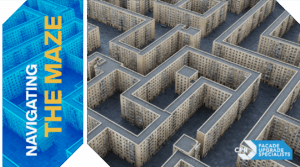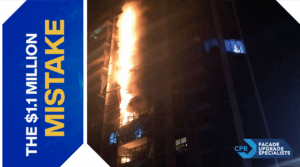To properly address structural cracks, it’s important to consult with a professional. They can assess the extent of the damage and recommend suitable repairs. Small hairline cracks may only need patching or sealing, while more severe structural damage might necessitate reinforcement or foundation repair.
Discovering cracks in your building can be concerning. It is important to understand the nature of these cracks. They can range from harmless minor issues to serious structural defects, compromising the structure’s safety. This guide will take you through a step-by-step approach to identifying the various types of cracks, the importance of professional assessments, and why you need to assess them. Whether you’re a homeowner or a property manager, knowing how to respond to these cracks is crucial to maintaining your building’s condition and ensuring safety for all the occupants.
Identifying Different Types of Structural Cracks
Building structural cracks can vary in their appearance. Each one is different regarding what can be understood as a basic underlying problem. From surface to deep structure faults, it is essential to understand the nature of the crack for proper management. Ignoring structural cracks can lead to further deterioration, compromising the building’s safety and stability. By identifying and addressing cracks early, you can prevent costly repairs and maintain the longevity of your property.
- Shrinkage Cracks
Shrinkage cracks are quite common in new constructions, and these are visible as the concrete dries out and decreases in volume. These cracks are usually thin and superficial and also tend to run parallel to the surface of the concrete. Though they may not pose any danger to structural integrity, they damage the appearance of the building if left unattended. Proper mixing and curing methods of concrete are very essential in reducing these kinds of cracks.
- Settlement Cracks
Settlement cracks appear when the ground below a building shifts or compresses unevenly; this causes some parts of the house to sink. These cracks usually form in a diagonal pattern on both interior and exterior walls. While some settlements are normal, the degree of excessive movement may point to soil stability issues or improper load distribution at construction time.
- Structural Cracks
>A crack is considered serious if it appears wide (wider than a quarter-inch), deep, and extends across structural components. Widening of the crack, accompanying structural deformities, or signs of leaks are indicative as well. Such cracks will impact the safety of the building and must be attended to urgently
- Thermal Cracks
Thermal cracks develop due to the expansion and contraction of building materials because of their reaction to temperature changes. This kind of cracking is common where there is a huge temperature change. Compared with the other categories, these are less serious structurally. They can be reduced by managing thermal insulation and using materials suitable for the local climate.
Different Types of Cracks in Buildings and Their Risks
When discussing cracks in buildings, it’s important to recognise that not all cracks carry the same level of risk. The different types of cracks in building structures include shrinkage cracks, settlement cracks, thermal cracks, and structural damage cracks. Understanding the types of structural cracks in buildings helps you determine whether you are facing a minor cosmetic issue or a situation where structural integrity is compromised.
For example, a simple crack in building plaster may be harmless, while diagonal building settlement cracks that widen over time may indicate foundation problems. Early diagnosis of these cracks in buildings ensures you choose the right building cracks solution before minor issues evolve into serious hazards.
Common Causes of Cracks in Building Structures
Cracks in building structures may originate from many other sources and, in most cases, are indicative of some constructional or environmental fault. It is very important to identify the causes of these for effective concrete crack repairs in Sydney. Here are some of the common causes of cracks:
- Foundation Movement
Foundation movement is one of the major causes of structural cracks, mainly where the soil is unstable. The settlement or shifting of soil because of variations in its moisture content, weak compacting, or a poorly designed foundation will cause a settling or shifting that causes cracks in the building. This should be treated promptly with the building maintenance measures to avoid further deterioration.
- Construction and Material Failures
The weaknesses in a building’s structure could be a result of faulty construction techniques or the use of low-quality materials. Inadequate concrete curing, improper concrete mixing, or the use of unsuitable materials are common issues that require repairs. Ensuring quality control during construction and using high-quality materials can reduce these risks.
- Environmental Factors
Temperature changes, humidity, and exposure to chemicals are environmental factors that affect the buildings’ materials, leading to cracks. For example, the temperature variation may cause the concrete to crack if it is not suitably designed to absorb those stresses using thermal expansion and contraction. Environmental considerations can be controlled through regular environmental assessments and concrete repairs.
- Overload
Overloading beyond capacity is one of the direct reasons for the structural cracks of a building due to either additional floors or heavy machinery installed without proper care for the building’s structure. This might be prevented through periodic inspections to ensure compliance with guidelines on the load it can bear.
- Age and Degeneration
As buildings get older, the materials deteriorate naturally, hence, their strength is reduced, resulting in cracking. Environmental exposure, repetitive load stress, and material fatigue combine to provide effects that result in the overall aging process. Regular building maintenance and renovations go a long way toward managing aging infrastructure and maintaining safety standard
- Importance of Professional Assessments
Professional assessments are necessary to ensure the overall structural integrity of any building. Property owners who involve experts ensure that the building is correctly diagnosed and managed appropriately, ensuring enhanced safety and preventing expensive future repairs.
High Cracks vs Low Cracks: What Do They Mean?
Property managers often ask about the difference between high cracks vs low cracks on a building’s walls. Cracks appearing high up on the structure are often linked to structural damage cracks caused by roof loads, temperature shifts, or long-term material stress. In contrast, low-level cracks near the foundation can point to cracks in cinder block foundation or soil movement issues.
In some cases, cracks that appear low on walls may simply be hairline shrinkage, but when these are combined with floor tilting or sticking doors, it’s a clear sign that structural cracks in buildings are forming. Knowing how to tell if a crack is structural allows building owners and strata committees to take timely action.
What Makes the Smart Spider Pro Ideal for High-Rise Building Maintenance?
The Smart Spider Pro is engineered specifically to meet the challenges associated with maintaining high-rise buildings. Its advanced features & innovative design make it a superior choice for various maintenance tasks. Here’s why the Smart Spider Pro is ideal for high-rise building maintenance:
- Accurate Diagnosis of Cracks
Professional assessments can allow one to identify precisely the type and severity of cracks within a building. The structural engineer will apply their knowledge and expertise to identify whether the cracks are superficial or if they’re indicative of deeper structural problems. This step is important in designing an effective concrete repair strategy to ensure that the integrity of a building is not compromised.
- Expert Recommendations for Repairs
Knowing the nature of the damage, professionals can then offer expert recommendations on the best ways to repair them. This may involve the selection of suitable materials and techniques for concrete repairs. This advice from experts ensures that crack repair is effective, sustainable, and suited to the particular needs of the building.
- Efficiency
It has been observed that the use of Smart Spider Pro reduces the time required for performing maintenance tasks. The design and the friendly interfaces enable the maintenance teams to perform their tasks effectively and within the shortest time possible without having to close the facilities for long.
- Compliance with Building Codes
Professional assessments ensure that each repair and construction is done according to the building codes and regulations concerned. Compliance is very critical to the issue of safety, but also for legal purposes, maintaining the value of the property while ensuring the local standards of building maintenance are met
- Long-term cost savings
Professional assessments can help save considerable amounts in the long run. If very minor problems are identified early, appropriate management of structural issues would prevent these issues from turning into major concrete repairs or complete rebuilds and would reduce future expenditure significantly while increasing the life span of the building.
Building Cracks and Remedies: Finding the Right Solution
When a building with cracks is left unattended, the risks grow over time. Effective building cracks solution approaches include professional sealing, epoxy injections, and in severe cases, reinforcement or underpinning. Specialist services are also available for concrete block crack repair and repairing cracks in structure caused by overloading or poor-quality materials.
CPR’s Scaffold-Free™ technologies and SKY-FIMMS® inspections provide precise mapping of every crack on building facades, helping determine whether the issue is cosmetic or if structural cracking requires urgent remediation. By tackling problems with engineered solutions, strata committees and managers not only safeguard residents but also achieve long-term savings by preventing repeated repairs.
Conclusion
Identifying and addressing cracks in the structure of your building promptly is important concerning maintaining safety, integrity, and value. Every step, from identifying the kind of crack to understanding the cause, can take you to a professional assessment and will be a serious factor in contributing to the health of your property
Frequently Asked Questions
How can I identify whether a crack is a structural one?
A structural crack will, in most cases, be directed diagonally across a wall, wide, or growing, and accompanied by other signs of distress, like not being able to close the doors or sloping floors. Such cracks have effects on the stability of the structure and usually require professional evaluation and repair.
How often should I inspect my building for cracks?
It is advisable to inspect your building for cracks at least annually. In the case of an older building, extreme weather conditions in the area, or issues of integrity in past years, more frequent monitoring, like seasonal or biannual, will help identify potential problems in good timing.
What does a professional assessment involve?
This would normally include a detailed examination of the building by a structural engineer or any other qualified inspector. Assessment is the investigation of the type, size, and location of the cracks, the determination of what causes them, checking for any associated structural damages, and recommending proper concrete repair or preventive measures.
What are some of the most common types of structural cracks?
The common types of structural cracks are the settlement cracks, which come as a result of shifting or settling of the foundation, the shrinkage cracks, which develop as concrete dries; and the structural cracks, which are caused by overload or faulty design. Each of these points to different levels of concern for the integrity of the building.
How do I know if a crack is serious?
A crack is considered serious if it appears wide (wider than a quarter-inch), deep, and extends across structural components. Widening of the crack, accompanying structural deformities, or signs of leaks are indicative as well. Such cracks will impact the safety of the building and must be attended to urgently.






